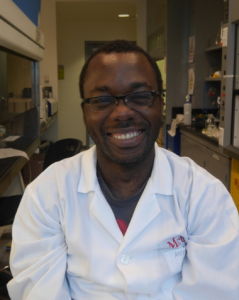
Miniaturization is a trend in our society. Just like it was important to reduce the size of computers, miniaturization of chemical and biological laboratory processes to a sub-millimeter scale is crucial. This is a challenge microfluidics is trying to overcome. Microfluidics systems, chips of a few mm/cm in size, are promising tools for bioanalysis. In addition to simplifying laboratory processes, microfluidics systems allow a reduction of costs because smaller reagent volumes, typically in µL, are needed. I had the chance to chat with two of the best researchers in Canada in this field, Dr. David Juncker and his post-doctoral fellow Dr. Ayokunle Olanrewaju.

You designed a test to rapidly detect UTI. What are the issues with current detection methods?
Ayokunle: The gold standard is urine culture, but the issue is that it takes 24h to get results. There are rapid methods like urine dipsticks that work quickly, in about 5 minutes, but they are not very accurate as they don’t directly target the bacteria. That’s why there is a need and an interest in methods that could very quickly, during a typical doctor’s office visit, determine if a person has UTI or not. That way the doctors wouldn’t have to guess, they would only give a prescription to the patient upon learning that they have a bacterial infection. This would help to reduce over-prescription of antibiotics and be an additional tool that could help to slow down the emergence of antibiotic-resistant pathogens.
You designed your test for UTI detection using microfluidics capillaric circuits (CC). Could you explain what is a CC?
Ayokunle: Capillaric circuit is a name we came up with for microfluidic devices in which the liquid is driven and controlled by capillary forces. There are other microfluidic methods for bacteria detection but for most of them you need external pumps like syringe or electrokinetic pumps to drive the liquid in the chip. For us, we just have our CC and it works autonomously with very little user intervention. We called it Circuit because we designed it like an electronic circuit: with valves and resistors. Basically, to make it work you just have to take the chip, put the liquids in and the direction, timing, and sequence of liquid flow is controlled entirely by the geometry and the chemistry of the chip. We designed our chip that way because we really wanted it to be portable and self-sufficient, a bit like an iPhone: you don’t want to be carrying around a generator every time you want to send a text message, you want it to be self-contained and self-regulated and respond to simple inputs. Capillaric circuits aim to be equally user-friendly, so that the doctor doesn’t need to have an electrokinetic pump or a syringe pump to do a UTI test.
How did you fabricate the CC?
Ayokunle: We used 3D printing to make them. 3D printing lets you make a new design every 30 minutes and so you can quickly iterate and optimize your design.
David: And that’s an advantage because in the past microchips were fabricated in a micro-fabrication facility using an expensive and slow fabrication process. Another advantage of 3D printing is that we can make big features, big reservoirs. We could then start to address problems where there is a need of larger volumes. Bacterial assays are one of the challenges where you need to have large volumes to compensate for the very low concentrations of pathogens. You need to screen a large sample to detect small amounts of bacteria.
Could you tell us more about how the test works?

Ayokunle: The way that they work is the following: the user loads the reagents required for the test into three reservoirs, one for the urine sample, one for biotinylated detection antibodies that recognize E.Coli within the urine sample, and one for a fluorophore conjugated to streptavidin. Streptavidin is a protein that binds to biotin. In this test, it binds to the biotinylated detection antibodies and gives a fluorescent signal that allows us to easily visualize the test results. These initial sample and reagent loading steps can be carried out in any sequence and up to 30 minutes before the doctor is ready to begin the test, because capillaric valves hold liquids in the reservoirs, making operation of the CCs easier for the doctor. Finally, when the doctor is ready to begin the test, a buffer containing microbeads functionalized with detection antibodies is loaded in the principal channel. These microbeads form a packed region where bacteria have to flow through. They are set up like an obstacle course to increase the chance of E.Coli being captured by them. This microbead addition step triggers the sequential release of the sample and assay reagents and will generate a fluorescent signal if bacteria is present. With this signal we can detect bacteria at concentrations as low as 103 colony forming units per millilitre (CFU/mL) which is well below the clinical diagnostic threshold for UTI (≥ 10^5 CFU/mL). This user-friendly and sensitive test is completed within 7 minutes with only four user steps, three of which can be carried out in advance.
You developed a Matlab script to automatically count the number of bacteria on microbeads. Therefore, the user needs to have Matlab and to know how to use it to obtain test results. How would you improve this aspect?

Ayokunle: The Matlab script was a simple way to analyze the results in our lab and to share them with other researchers. In the future we could make it even more automated. We could easily transform a Matlab program into an executable program where the user just has to double-click and doesn’t have to worry about Matlab. The paper we published is a proof-of-concept, it is not the final result. In the next iteration, we would like to improve the read-out of the test. For example, we are thinking about making a simple visual readout visible to the naked eye. That way the user can get a simple yes or not result just by looking at the color.
How would you implement such colorimetric detection?
Ayokunle : Because we have a biotin-streptavidin reaction, the simplest way we can switch to a colorimetric reaction is just to switch fluorescent streptavidin to streptavidin conjugated with nanogold. On white surfaces nanogold appears red, just like in a pregnancy test. When switching to nanogold the question is: how strong is the signal compared to fluorescence? We expect that, going from fluorescence to colorimetric detection will result in some drop in performance but we could overcome that by introducing a signal amplification component to the colorimetric detection. There are many commercially available colorimetric immunoassay reactions that are commonly used in clinical laboratories that we can miniaturize and automate with our CC.
You developed this chip for UTI but could you easily adapt it for other bacterial diseases such as cholera?
Ayokunle: The nice thing about the CC is that the antibody controls what kind of bacteria you capture. In principle to develop a test for Cholera I could find antibodies against the bacteria that causes cholera and put them in the chip. The catch is that the type of sample that you are testing also matters. One of the reasons we started with UTI was because urine is a relatively simple sample to work with. If you work with cholera then you need to collect sputum and you first have to break it down and make sure it flows through your chip. There are ways to do this, but the sample preparation is more complicated and we’d need to validate it on our CC first. The other thing to think about is: how many bacteria do you need to detect for your test to be clinically useful. For instance, if you are making a test to detect bacteria in drinking water you need to find something like 1 bacteria in a 100mL. That is no longer a microfluidic problem, it is a millifluidic one. Two of the most important things to consider when designing a bacteria detection test: the kind of sample you start with and the number of bacteria you need to be able to detect.
So your CC has the potential to be used for the detection of other bacteria. In addition it is easy-to-use and low-cost. I believe that these characteristics are giving your CC a great potential to be used in low-income countries. Do you think your CC could be used in these countries? Otherwise, how would you optimize it?
Ayokunle: One of the challenges as you think about where you want to use your chip is to consider what people actually need there. For example, in many resource-limited settings you want to avoid cold storage of reagents and ensure that your test works at high temperatures and humidity. Also the ideal scenario would be to have only one user step, the addition of your urine sample, so that the test is as user-friendly as possible. This could be done by drying reagents in the chips. So I would say that the potential is there, but we are at a very early-stage and need more resources (people, time, and money) to make this test useful both in point-of-care settings and/or in resource-limited settings.
What are the next steps for the project?
Ayokunle: The next big step is testing with patient urine samples. We have already tested with a laboratory strain of E.Coli, but we need to make sure that the CC also detects different strains from different people. We also need to test a large enough number of people to determine the false positive and negative rates. Another interesting science problem to work on would be to comment on whether the captured E.Coli are antibiotic-resistant or not.
If E.Coli is antibiotic resistant, what is going to happen?
Ayokunle: If you know right away that it is resistant then you can give the patient the top of the line, most effective antibiotics. However, you don’t want to use those top of the line antibioticswithout first knowing that the bacteria is resistant because, first of all, the more you use an antibiotic the more likely bacteria are to develop resistance to it, and secondly, because sometimes the most effective antibiotics can have more severe side effects so you really don’t want to use those antibiotics unless you truly need to.
Finally, you mentioned a spin-off of the laboratory , can you tell us some more?
Ayokunle: A former PhD student of the lab, Dr Roozbeh Safavieh, started a company called Sensoreal2. The big thing that the company is working on right now is a capillaric circuit to detect proteins in blood that will be used by astronauts on the International Space Station3. The Canadian Space Agency wanted a research tool to study protein changes in an astronaut’s blood with an eye towards future deep space missions. Sensoreal’s contribution is making a microchip that performs this blood test using capillary forces and without moving parts. Capillaric circuits are especially well suited for biological tests in space because even though there is no gravity, capillary forces still exist, in fact they’re even more easily observed4 and the chip still works very well.
Ayokunle and David successfully designed a capillaric circuit capable of detecting bacteria in urine in 7 minutes. I am now convinced, and I hope that you readers are too, that these self-powered microfluidics systems are extremely promising and that they could be used to address many scientific challenges. It is a very inspiring project and I am looking forward to seeing what is going to happen next.
1- Olanrewaju, A. O., Ng, A., DeCorwin-Martin, P., Robillard, A., & Juncker, D. (2017). Microfluidic Capillaric Circuit for Rapid and Facile Bacteria Detection. Analytical Chemistry, 89(12), 6846-6853.
Images and videos were retrieved from the David Juncker’s laboratory website5 , the original paper1 and Youtube6.
